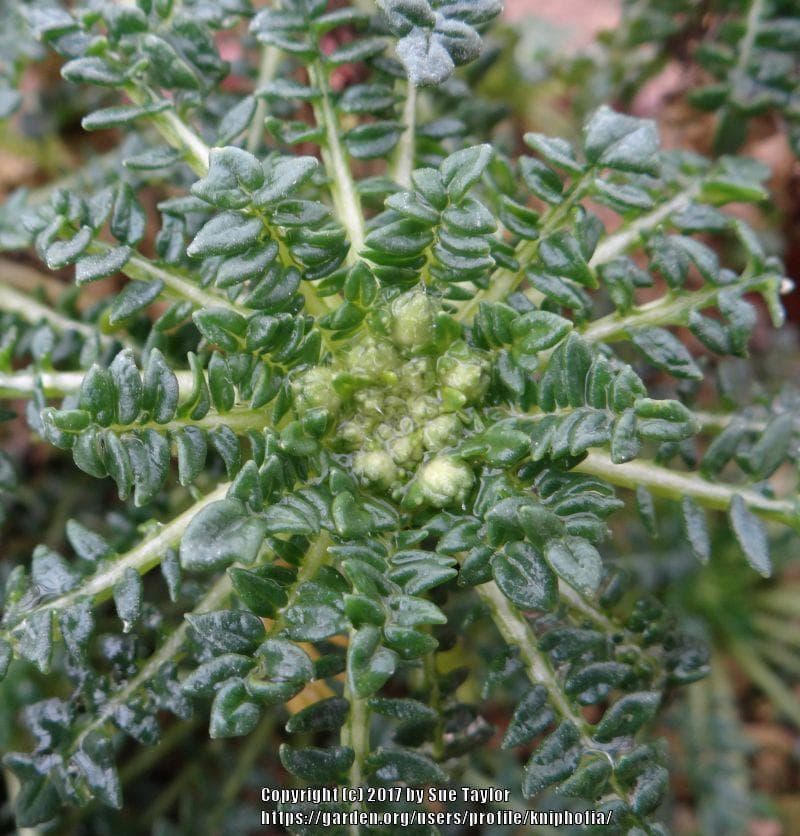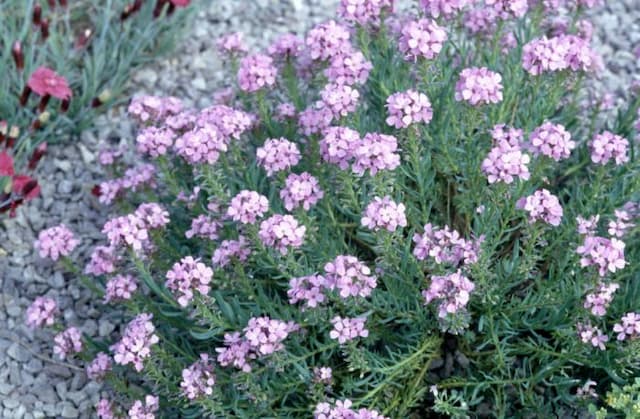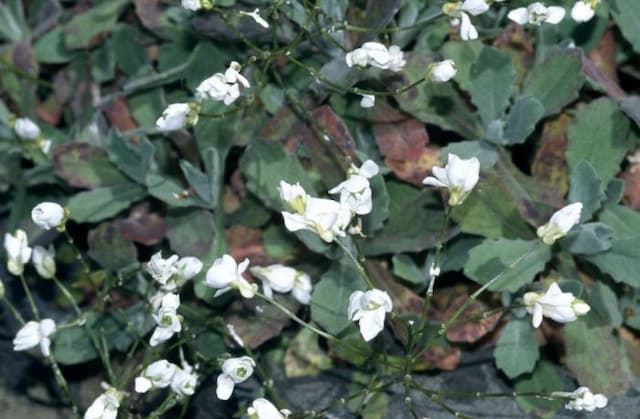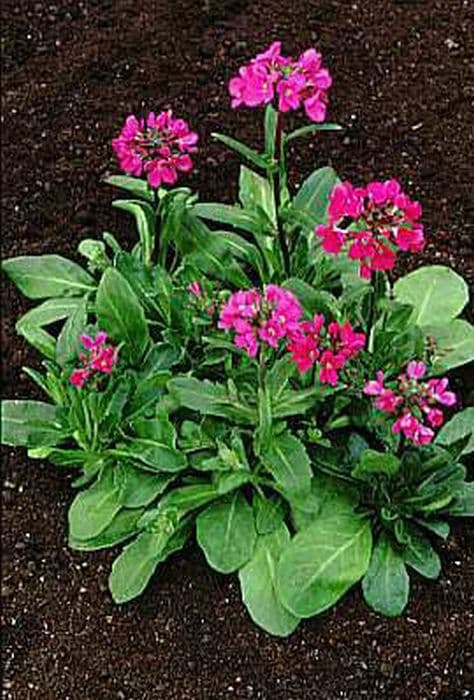Morisia monanthos does not have a widely recognized common name. Morisia monanthos 'Fred Hemingway'

ABOUT
Morisia monanthos 'Fred Hemingway', often known simply as Morisia, is a charming perennial that features a low-growing, rosette-forming habit. Its leaves are typically bright green, with a glossy sheen, and form a dense and neat basal cluster. The foliage tends to be narrow and spoon-shaped, forming a textured mat on the ground. Come flowering season, Morisia 'Fred Hemingway' produces beautiful blooms that can captivate any onlooker. The flowers rise slightly above the foliage on short stems, each sporting a singular, daisy-like appearance. The petals are vibrant yellow and radiate from a central disk that may have a different hue, often attracting pollinators. The stark contrast between the sunny flowers and the glossy green leaves creates a visually striking display. After blooming, the plant may set seed in small capsules, adding another element of interest to its appearance. Overall, Morisia 'Fred Hemingway' adds a colorful and ornamental touch to garden spaces, rockeries, or borders where its showy blooms and evergreen foliage can be displayed to full effect.
About this plant
 Names
NamesFamily
Brassicaceae
Synonyms
Corsican Gold, Corsican Rockfoil
Common names
Morisia monanthos.
 Toxicity
ToxicityTo humans
There is limited information available regarding the toxicity of the Golden Creeping Mesemb specifically and the information regarding the broader genus Morisia to humans is not well-documented or widely known. As with many plants, it is always advisable to exercise caution and avoid ingesting parts of plants that are not known to be safe for consumption. If ingested, watch for any symptoms of general plant poisoning which can include nausea, vomiting, diarrhea, and abdominal pain. If such symptoms occur or if there is any doubt about potential poisoning, seek medical attention promptly.
To pets
The toxicity of the Golden Creeping Mesemb to pets, including cats and dogs, is not well-documented. Therefore, caution should be exercised to prevent pets from ingesting this plant. If a pet ingests any part of the plant, be observant for symptoms of plant toxicity in pets, which can vary but might include vomiting, diarrhea, excessive drooling, lethargy, or abnormal behavior. If any symptoms develop or you suspect your pet has ingested the plant, contact a veterinarian as soon as possible.
 Characteristics
CharacteristicsLife cycle
Perennials
Foliage type
Evergreen
Color of leaves
Green
Flower color
Yellow
Height
3 inches (7.62 cm)
Spread
6 inches (15.24 cm)
Plant type
Herb
Hardiness zones
8
Native area
Mediterranean
Benefits
 General Benefits
General Benefits- Easy to grow: Morisia monanthos 'Fred Hemingway' is known for being relatively easy to care for, requiring minimal maintenance.
- Drought Tolerant: Once established, it can withstand periods of dry conditions, making it ideal for xeriscaping or low-water gardens.
- Attracts Pollinators: This plant produces flowers that can attract bees and butterflies, which are beneficial for pollination in the garden.
- Ornamental Appeal: With its distinctive flowers, Morisia monanthos 'Fred Hemingway' adds visual interest and color to landscaping.
- Ground Cover: It can serve as a ground cover due to its low-growing nature, helping to reduce soil erosion and suppress weed growth.
- Rock Gardens: Its adaptability to rocky and sandy soils makes it a perfect choice for rock gardens or alpine plantings.
- Seasonal Interest: Morisia monanthos 'Fred Hemingway' provides seasonal interest with its blooming cycle, adding dynamism to the garden throughout the year.
 Medical Properties
Medical PropertiesThis plant is not used for medical purposes.
 Air-purifying Qualities
Air-purifying QualitiesThis plant is not specifically known for air purifying qualities.
 Other Uses
Other Uses- Morisia monanthos, also known as Gold Coin Plant, can be used in miniature or fairy gardens due to its small size and attractive foliage, providing a whimsical aesthetic to these creative landscaping projects.
- In gastronomy, the edible flowers of the Gold Coin Plant can be used as a colorful garnish for salads, desserts, or cold dishes, adding a unique touch to culinary presentations.
- As a natural fabric dye, the flowers and leaves can be boiled to produce a yellow to greenish hue for dyeing textiles or in artistic endeavors.
- The plant's intricate root system can be beneficial in preventing soil erosion on slopes and banks in garden landscapes, helping stabilize the ground.
- Gold Coin Plant can be used as part of a living roof or green roof project, where it can contribute to insulation, biodiversity, and aesthetic appeal due to its low-growing habit and drought resistance.
- Photographers and artists may employ the plant as a subject or backdrop in macro photography and botanical illustrations, where its bright flowers and rosette-forming leaves add visual interest.
- The dried flowers can be incorporated into potpourri mixes for a natural fragrance in homes, adding a subtle floral scent to living spaces.
- In educational settings, the Gold Coin Plant can be used to teach children about plant biology and lifecycles in hands-on science projects due to its quick growth and easy-care nature.
- The plant can be utilized for the practice of phytoextraction in mild cases, where it would help to remove certain heavy metals from contaminated soil during growth.
- For those involved in nature crafts, the leaves and flowers of the Gold Coin Plant can be pressed and used in the creation of botanical paper, bookmarks, or other delicate craft items.
Interesting Facts
 Feng Shui
Feng ShuiThe Morisia is not used in Feng Shui practice.
 Zodiac Sign Compitability
Zodiac Sign CompitabilityThe Morisia is not used in astrology practice.
 Plant Symbolism
Plant SymbolismI'm sorry, but there is no known symbolic meaning for Morisia monanthos 'Fred Hemingway', as it is not a plant with commonly recognized symbolism. This species does not hold a significant place in cultural or historical lore that would attribute symbolic meaning to it. Therefore, I cannot provide a list of symbolic meanings and their explanations for this specific plant.
 Water
WaterThe common name for Morisia monanthos 'Fred Hemingway' is Corsican Rockfoil. This plant thrives in moist but well-drained soil, so it's essential to water it thoroughly when the top inch of soil feels dry to the touch. Corsican Rockfoil typically requires watering approximately once a week, but this can vary based on climate and weather conditions. Ensure each watering is deep enough to saturate the root zone. A good measure is to provide about half a gallon of water every seven to ten days during the growing season, reducing the frequency during dormant periods.
 Light
LightCorsican Rockfoil prefers full sunlight to partial shade. The best spot for this plant would be a location where it can receive at least six hours of sunlight daily. However, it should be protected from the harsh afternoon sun in hotter climates to prevent scorching of the leaves.
 Temperature
TemperatureCorsican Rockfoil is able to withstand temperatures down to about 5°F and up to around 80°F. The ideal temperature range for Corsican Rockfoil is between 60°F and 75°F. Protection from extreme cold and frost is necessary to maintain the health of the plant.
 Pruning
PruningPruning is usually not necessary for Corsican Rockfoil except to remove any dead or damaged foliage to maintain plant health and appearance. The best time to prune is in early spring before new growth begins. Pruning can also stimulate denser growth if done correctly.
 Cleaning
CleaningAs needed
 Soil
SoilThe best soil mix for Morisia monanthos, commonly known as the Corsican wallflower, should be well-draining with a mix of sand, peat, and loam. A slightly acidic to neutral pH of 6.5-7.5 is ideal for this plant.
 Repotting
RepottingCorsican wallflower does not require frequent repotting; it can be done every few years or when the plant outgrows its container, ensuring minimal root disturbance.
 Humidity & Misting
Humidity & MistingCorsican wallflower prefers moderate to high humidity levels but can tolerate lower humidity if not exposed to drying winds and with adequate soil moisture.
 Suitable locations
Suitable locationsIndoor
Place in bright, indirect light and avoid overwatering.
Outdoor
Choose a sunny spot with well-draining soil and shelter from winds.
Hardiness zone
7-9 USDA
 Life cycle
Life cycleMorisia monanthos, commonly known as Fred Hemingway, starts its life cycle when seeds are sown in well-draining soil in autumn or spring. The seeds germinate, and the plant emerges as a rosette of spiky, green leaves, entering its vegetative stage. Once established, it develops a deep taproot to access water and nutrients from the soil. After its first year or when conditions are favorable, usually in spring, it blooms, producing bright yellow, cup-shaped flowers. Once pollination occurs, it develops seed capsules containing multiple seeds, completing its reproductive phase. After dispersal, the seeds enter a period of dormancy until the next suitable season for germination, continuing the cycle.
 Propogation
PropogationPropogation time
Spring
Propogation: Morisia monanthos 'Fred Hemingway', commonly known as Corsican Goldilocks, can most commonly be propagated through seed. The best time for sowing seeds is in the fall or late winter, which allows for a period of cold stratification that is often necessary for germination. To propagate Corsican Goldilocks by seed, sow the seeds thinly on the surface of a well-drained seed starting mix and lightly cover with soil. Place the container in a cold frame or a sheltered outdoor spot. Seeds will germinate in the spring as temperatures rise. It's crucial to keep the soil moist but not waterlogged, and once seedlings are large enough to handle, they should be transplanted into their own pots or a suitable location in the garden.






![Aubrieta [Axcent Burgundy]](/_next/image?url=https%3A%2F%2Fplants-admin.emdemapps.com%2Fimages%2Fplants%2F%2Fimages%2F604b5b7b548d8.png&w=640&q=75)


